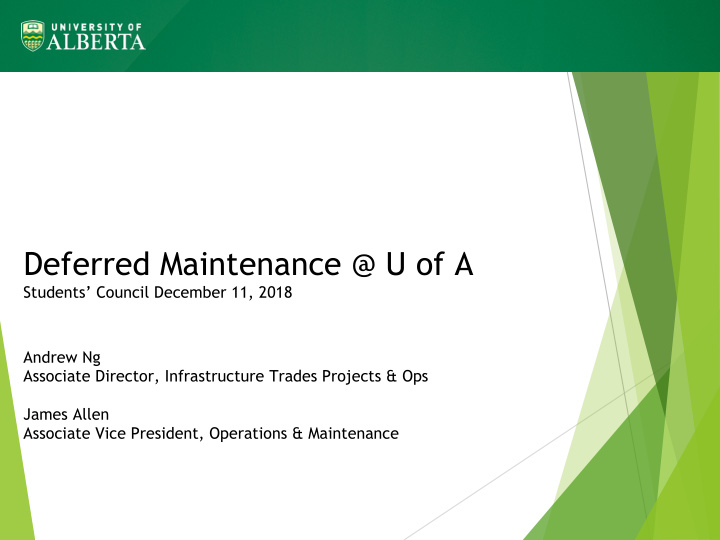



Deferred Maintenance @ U of A Students’ Council December 11, 2018 Andrew Ng Associate Director, Infrastructure Trades Projects & Ops James Allen Associate Vice President, Operations & Maintenance
Our Infrastructure – The Facts v ~17.5M ft2 of space, more than any other Canadian university. v 0-110 year old campus v Mix of simple and complex buildings
What is Deferred Maintenance? Annual Maintenance Requirements + Deferred Action = Deferred Maintenance v Deferred Maintenance can look like: v Floods in spaces v Heating/Power loss in a building v Equipment failures leading to impacts on research.
Why should you care about Deferred Maintenance? v Risk to the Institution, Academic Mission Impact to student usage/occupancy v Impact to research outcomes v v DM is increasing unsustainably. Building system failures will be more numerous, more intense, and more often.
So what is this $1B I read about?
Current DM vs. 5 Year Projection Total Supported Unsupported ($ million) ($ million) ($ million) Current deferred 311 380 69 maintenance 5-year projection 888 981 93 Figures pulled from the Government of Alberta Deferred Maintenance database. Our experience shows that these figures are understated by an average of 40%.
So how did we get here? v Deferred Maintenance primarily driven by maintenance budget limitations. v 1% – 4% of building value for maintenance industry standard. Translated: $63.1M – $252.4M. v So where are we at?
0.7%
How is maintenance funded? Infrastructure Shortfall to 1% Shortfall to 2% Maintenance Maintenance Operating Program ($ million) ($ million) ($ million) ($ million) ($ million) Total FY 34.0 97.1 2014/15 19.8 9.3 29.1 36.3 99.4 2015/16 17.5 9.3 26.8 30.2 93.3 2016/17 23.6 9.3 32.9 18.9 82.0 2017/18 34.9 9.3 44.2 18.9 82.0 2018/19 34.9 9.3 44.2
What does our situation look like?
Key: Deferred Maintenance (North Campus) <Building> <Deferred Maint.> <FCI> Good Fair Poor FY 2017/2018 <Approx. Replace. Value>
Key: 5 Year Maintenance Projection <Building> <Deferred Maint.> <FCI> Good Fair Poor (North Campus) FY 2017/2018 <Approx. Replace. Value>
North Campus (Understanding the Bow Wave) FY 17/18 What does the bow wave look like close up? Modern Pre War Post War Complex Buildings over 50 Buildings 10 to Buildings Buildings 25 to 50 25 Under 10 Life cycles of major building components are past due. Failures are possible. Core Major envelope and modernization cycles are missed. Short life-cycle Little work. mechanical life cycles come needs; primarily “Honeymo due. Functional Highest risk (11%) space renewal. on” period. obsolescence prevalent. High risk (42%) Medium Risk Low Risk (18%) (29%)
Deferred Maintenance and 5 Year Maintenance Projection: By Category Current Deferred Maintenance 5 Year Projection $431M S4 - Mechanical S4 - Mechanical 33% 44% $127M S2 - Envelope S3 - Interior $79M $153M S3 - Interior S2 - Envelope $52M $129M S6 - Facility Equipment S5 - Electrical $43M $129M and Built-in Furniture S6 - Facility Equipment S5 - Electrical $41M $93M and Built-in Furniture S7 - Site S7 - Site $19M $25M S1 - Structural S1 - Structural $9M $9M $380M $980M S8 - Special S8 - Special $7M $7M (Supported +Mixed + (Supported +Mixed + Unsupported) Unsupported) Other Other $2M $2M
Current Deferred Maintenance: Where We Are Today Supported & Mixed Buildings By Category S4 - Mechanical $113M Supported & Mixed Buildings By Criticality S2 - Envelope $60M 5 - Critical 17% $54 S3 - Interior $39M 4 $34 11% S5 - Electrical $37M S6 - Facility $35M Equipment… 3 $114 36% S7 - Site $15M 2 $55 18% S1 - Structural $7M S8 - Special 1 - Low $56 18% $4M Other $2M
So what do we do now?
Improving Maintenance v Preventive Maintenance – catching things before they fail. v Enhanced Maintenance Planning – triaging critical systems first.
A multi-faceted approach Energy and Safety Sustainability Faculty Institutional Master Priorities Planning Operational Academic Criticality Mission Priority Funding Building Projects Streams Utilization
Into 3 main pillars v Renew and Repurpose v Make strategic investments in our facilities. v Space Optimization v Better utilize our space on campus. v Asset Reduction v Remove infrastructure where renewal and maintenance costs outpace financial sustainability.
Targeted Investment Central Academic Building Humanities Centre • Built in 1971 • Built in 1972 • ~160k square feet • ~160k square feet • Office and Classroom Space • Office and Classroom Space with Basement Cafeteria predominantly • DM: $6.5M • DM: $6.9M Central Academic Humanities Centre • FCI: 0.19 • FCI: 0.14 $6.5M DM $6.9M DM How can data analysis help us decide? • Operational Criticality as a first metric • Probability of failure • Impact of failure on academic mission and building occupants • Expected time for recovery • Risk of cascading failures
Recommend
More recommend